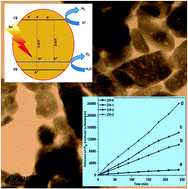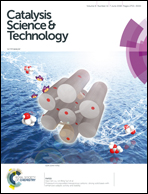Perforated N-doped monoclinic ZnWO4 nanorods for efficient photocatalytic hydrogen generation and RhB degradation under natural sunlight†
Abstract
The synthesis of novel nitrogen-doped zinc tungstate (N-doped ZnWO4) perforated nanostructures and their photocatalytic activity for hydrogen production from water and rhodamine B degradation under direct sunlight have been demonstrated for the first time. ZnWO4 was synthesized by a simple hydrothermal method and doped with nitrogen by precise thermal treatment in the presence of thiourea to obtain perforated nanorods. The structural analysis carried out by X-ray diffractometry (XRD) and first principles density functional theory (DFT) based calculations shows a monoclinic structure. The microstructural and morphological studies show unique perforated nanorods with diameters of 25–20 nm of N-doped ZnWO4. The substitution of nitrogen in place of oxygen atoms was confirmed by X-ray photoelectron spectroscopy (XPS). The effective substitution of nitrogen in ZnWO4 extends the absorption bands into the visible region. Hence, a computational study of N-doped ZnWO4 was also performed for the investigation and confirmation of its crystal and electronic structures. UV-DRS and analysis of the density of states (DOS) indicate a band gap of ∼2.4 experimentally and 2.9 eV theoretically. Considering the band structure, its functionality as a sunlight driven photocatalyst for water splitting and dye degradation has been investigated. N-Doped ZnWO4 exhibits enhanced photocatalytic activity towards hydrogen evolution (5862.1 μmol h−1 g−1) for water splitting as well as RhB degradation under natural sunlight. The enhanced photocatalytic activity of N-doped ZnWO4 is attributed to extended absorbance in the visible region, which in turn generates more electron–hole pairs responsible for higher H2 generation. DFT calculations suggest that the hybridization between O-2p and N-2p at the valence band edge is the reason for the narrowing band gap, and the degree of hybridization is likely to be increased with an increase in N doping which is responsible for the higher activity. The present investigation demonstrates a novel approach for the synthesis of perforated N-doped ZnWO4 with great prospects of scaling up and high yields.



 Please wait while we load your content...
Please wait while we load your content...